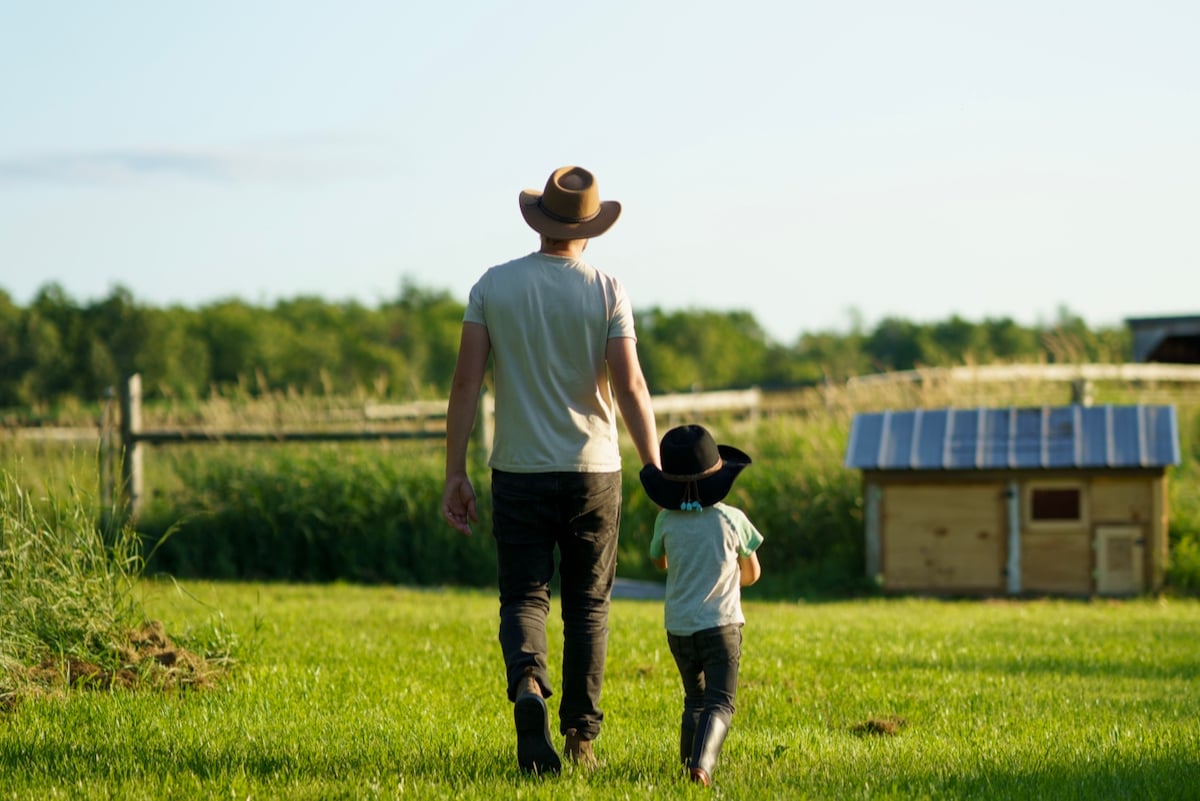In a modest house in an older neighbourhood in Winnipeg’s south end, there’s a simple dining room table. Surrounded by four chairs, it’s a traditional table as dining tables go. In most ways, in fact, it’s an absolutely ordinary table, exactly like millions of similar tables in similar homes all across Canada.
But to John Toone and Carol Drosdowech, it’s a very special table. It’s their family dinner table.
For farmers, it’s a very special table too, because of the food that’s getting eaten there.
Read Also

A new spin on farm legacy
What does farm legacy look like for the next generation.
Every night at about 5 p.m., the Toone-Drosdoweches sit down to their evening meal. The couple talks about the events of the day. They plan for the next day, and they enjoy a little time together with their two young children, a boy who’s five and a two-and-a-half year-old girl.
“We’re big on a sit-down meal every night,” says Toone.
A generation or two ago, that might have been an unremarkable statement. After all, having dinner together was a big part of what being a family was all about. But over the past several decades, busy lifestyles have pulled families out of the kitchen and into drive-through lanes across Canada.
It’s been a trend that coincided roughly with the industrialization of agriculture and the advent of more and more prepared meals and processed foods.
Today, that trend may have passed its peak.
More and more families like the Toone-Drosdoweches are beginning to take a long, hard look at their food choices. “You want to make sure that you’re getting the best-quality products that you can afford,” says Toone, who adds that it was the arrival of his children that led him to rethink his food choices.
To Toone and his family, that’s meant spending more time in the kitchen. It’s also meant a revolution in the way they buy foods. Today they’re far less likely to head down to the local grocery store and far more likely to pick up the phone and call one of a growing number of farmers who are marketing direct to consumers.
Sometimes it’s a bit more work. Frequently it means buying in bulk. And occasionally the results can be downright comic, like when a farmer couldn’t find Toone’s house and they made arrangements to meet at a local mall.
“I felt like I was making some sort of drug deal in the Grant Park parking lot, but I was just buying 50 pounds of flour,” Toone says.
Even so, Toone is convinced. Knowing where his family’s food comes from is more than worth the odd inconvenience.
It doesn’t matter to Toone if the bulk of Canadian farmers think he’s right or wrong. It’s what he believes in, it’s what in his mind makes him a better father.
Besides, it’s his money and he’ll spend it as he sees fit. Spending it on fancy or different food is no more foolish than, say, spending it on a certain truck with a special trim package.
Toone is convinced, and he’s determined, and that determination is something Canada’s farmers are just beginning to learn about and understand.
Face to face
At about the same time that Country Guide was talking to Toone, Ian Smith was delivering frozen pork to a customer in Winnipeg. The customer was looking over the bill and getting ready to write a cheque before turning to Smith and said some words that most farmers have never heard.
“You know,” the customer said, “we’re willing to pay you more.”
Those few words capture the essence of Smith’s business, delivering tasty pork to consumers — including the Toone clan — who want to know a bit more about what they eat. Those words are also the key to the surprising success of a farm that can best be described as old school, and a farmer who might be considered by his neighbours as a throwback to days gone by — admittedly with a modern twist.
It all started in 1993 when Smith bought his parents’ farm. Originally a dairy farm, the family had moved to the property in the Interlake region at Grosse Ile in 1953 and then added a small farrow-to-finish operation in 1967. As
agriculture became more and more concentrated in the 1980s and 1990s, and as farms morphed into larger and larger specialized units, the Smith farm seemed almost to get left behind, continuing on in the tradition of the small mixed farm.
Then, when Smith announced to his friends, neighbours and co-workers that he was leaving the provincial Highways Department to pursue his dream on the family farm, the reaction was swift and brutal.
“They all thought I was crazy,” Smith says matter of factly. “They all told me the farm was too small, I’d never make it, that I was giving up a secure job with vacations and a pension.”
Up to a point, he admits, they were right. The farm was a struggle, though Smith says the family’s philosophy of growing slowly and refusing to take on debt certainly helped keep the operation viable.
Then, 10 years after taking over the farm, Smith heard a beef producer talking during the height of the BSE crisis about marketing beef over the Internet. Says Smith: “I didn’t own a computer and had no intention of getting one — but I thought, ‘Why can’t a pork producer do that too?’”
A few weeks later Smith was unpack-
agriculture became more and more concentrated in the 1980s and 1990s, and as farms morphed into larger and larger specialized units, the Smith farm seemed almost to get left behind, continuing on in the tradition of the small mixed farm.
Then, when Smith announced to his friends, neighbours and co-workers that he was leaving the provincial Highways Department to pursue his dream on the family farm, the reaction was swift and brutal.
“They all thought I was crazy,” Smith says matter of factly. “They all told me the farm was too small, I’d never make it, that I was giving up a secure job with vacations and a pension.”
Up to a point, he admits, they were right. The farm was a struggle, though Smith says the family’s philosophy of growing slowly and refusing to take on debt certainly helped keep the operation viable.
Then, 10 years after taking over the farm, Smith heard a beef producer talking during the height of the BSE crisis about marketing beef over the Internet. Says Smith: “I didn’t own a computer and had no intention of getting one — but I thought, ‘Why can’t a pork producer do that too?’”
A few weeks later Smith was unpack-
ing his computer and tapping his sister-in-law to set up the first rudimentary website for the farm. Then the question was, how to get the word out. It meant a ninth-grade dropout was going to have to learn a thing or two about marketing.
One of his early decisions was breathtakingly strategic.
A natural ally, he decided, was a group that many people in the pork industry see as a natural enemy — the Winnipeg Humane Society. Smith found out the group was offering certification for pork that was produced humanely, so he picked up the telephone and asked for a meeting with the group’s then executive director Vicky Burns.
“I asked her where they were with it, and she told me that it had sort of fallen by the wayside because nobody (in the pork industry) seemed interested,” Smith says. “I told her I thought I would be.”
Armed with the humane society guidelines, Smith quickly realized that for an old-school operation like his, there wouldn’t be many changes required. He was already using straw bedding, and the operation allowed the animals ample room to roam and root. Farrowing crates were generous enough to allow the sows to lay down, and were only used briefly while the piglets were at their youngest and most vulnerable. In fact, just a single change was required to the farm’s production system to meet the new certification guidelines.
“We had to stop docking the piglet’s tails,” Smith says. “The funny thing was that we hadn’t docked them for years and had only started doing that a few years earlier.”
Smith knew the humane production stamp was likely newsworthy, so he began with a few phone calls to the local media and was lucky enough to snag a story in the province’s biggest daily newspaper, the Winnipeg Free Press.
The response was immediate. “My sister-in-law called me at 7:30 that morning, to tell me the story was in the paper,” Smith recalls. “Then I hung the phone up, and it started ringing again and didn’t stop until 10 o’clock that night with calls from people who wanted to know about my pork. I also got about 300 hits on my website that day.”
Tellingly, Smith says his operation carries two certification marks — the Canadian Pork Council’s CQA (Canadian Quality Assurance) designation and the Winnipeg Humane Society’s stamp of approval.
“My customers have absolutely no idea what CQA is — but they sure know what the Humane Society is,” Smith says.
Smith says he has all sorts of customers, but there are two main groups. There are older folks who remember the quality of the meat they used to get from their corner butcher. Then there are young Generation Y’ers — the 20-to 28-year-old crowd that Smith describes as incredibly knowledgeable.
“It’s amazing the questions they’ll ask,” Smith says. “They want to know what I feed the pigs, whether I’m feeding antibiotics — all sorts of things.”
Along with a willingness to meet his customers’ needs, Smith also puts a lot of effort into establishing good and ongoing relationships with his customers. He answers ever phone call, delivers every shipment, makes a follow-up call a few weeks after each delivery.
This past Christmas, Smith even set
ing his computer and tapping his sister-in-law to set up the first rudimentary website for the farm. Then the question was, how to get the word out. It meant a ninth-grade dropout was going to have to learn a thing or two about marketing.
One of his early decisions was breathtakingly strategic.
A natural ally, he decided, was a group that many people in the pork industry see as a natural enemy — the Winnipeg Humane Society. Smith found out the group was offering certification for pork that was produced humanely, so he picked up the telephone and asked for a meeting with the group’s then executive director Vicky Burns.
“I asked her where they were with it, and she told me that it had sort of fallen by the wayside because nobody (in the pork industry) seemed interested,” Smith says. “I told her I thought I would be.”
Armed with the humane society guidelines, Smith quickly realized that for an old-school operation like his, there wouldn’t be many changes required. He was already using straw bedding, and the operation allowed the animals ample room to roam and root. Farrowing crates were generous enough to allow the sows to lay down, and were only used briefly while the piglets were at their youngest and most vulnerable. In fact, just a single change was required to the farm’s production system to meet the new certification guidelines.
“We had to stop docking the piglet’s tails,” Smith says. “The funny thing was that we hadn’t docked them for years and had only started doing that a few years earlier.”
Smith knew the humane production stamp was likely newsworthy, so he began with a few phone calls to the local media and was lucky enough to snag a story in the province’s biggest daily newspaper, the Winnipeg Free Press.
The response was immediate. “My sister-in-law called me at 7:30 that morning, to tell me the story was in the paper,” Smith recalls. “Then I hung the phone up, and it started ringing again and didn’t stop until 10 o’clock that night with calls from people who wanted to know about my pork. I also got about 300 hits on my website that day.”
Tellingly, Smith says his operation carries two certification marks — the Canadian Pork Council’s CQA (Canadian Quality Assurance) designation and the Winnipeg Humane Society’s stamp of approval.
“My customers have absolutely no idea what CQA is — but they sure know what the Humane Society is,” Smith says.
Smith says he has all sorts of customers, but there are two main groups. There are older folks who remember the quality of the meat they used to get from their corner butcher. Then there are young Generation Y’ers — the 20-to 28-year-old crowd that Smith describes as incredibly knowledgeable.
“It’s amazing the questions they’ll ask,” Smith says. “They want to know what I feed the pigs, whether I’m feeding antibiotics — all sorts of things.”
Along with a willingness to meet his customers’ needs, Smith also puts a lot of effort into establishing good and ongoing relationships with his customers. He answers ever phone call, delivers every shipment, makes a follow-up call a few weeks after each delivery.
This past Christmas, Smith even set
“ I’ve Set My Price, And My Customers Are Willing To Pay It. I Still See A $100 Bill On Either Flank.”
— Ian Smith
aside three evenings to call each and every one of his customers to wish them the best of the season and simply say “thanks for the business.”
“You don’t have to be pushy, but you do have to work at it,” is the way Smith describes it.
From a customer perspective, says John Toone, it’s a feel-good experience that’s a world apart from the sterile process of buying his meat from the local grocer.
“To start with, Ian’s about the nicest guy you’ll ever meet,” Toone says. “It’s also the little things, like a call two weeks after he makes a delivery, just to make sure everything is OK. You don’t ever get a call from Superstore.”
Smith concedes this type of farm marketing model or even lifestyle isn’t for everyone — but it works for him.
“They were right about one thing when I took over the farm — I don’t get many holidays,” Smith says. “But Fridays (his delivery day) are kind of my holidays. I look forward to them, and the chance to meet people.”
And has it been a hassle to learn all the ins and outs to direct market his products?
“Oh no — it’s been fun,” Smith says. “It’s a challenge.”
And how about economically? Well, hog producers across the country are in desperate straits. The pork industry worldwide is in the grip of a ferocious downturn, and in Canada, where the industry is also fighting American protectionist manoeuvring, the federal government just announced a program of grants aimed at easing more farmers out of hog production.
Yet business on the Smith farm continues on unabated.
“I’ve set my price, and my customers are willing to pay it,” Smith says. “I go out there to the barn and I look at those hogs and I still see a $100 bill on either flank.”
So how do customers feel about paying more? Well, at least some argue they’re actually paying less, once all the middlemen are cut out of the deal.
Toone knows there are stereotypes. He knows that in some circles, people who make their own food choices are considered rich, spoiled urbanites with more money than brains. He contends the stereotype is miles away from the reality, and he points to his own family as proof. He’s a writer and his wife Carol is a part-time teacher — neither a get-rich-quick scheme.
“We’re not all rich,” Toone insists. “We actually find this to be much more affordable.” CG
“ I’ve Set My Price, And My Customers Are Willing To Pay It. I Still See A $100 Bill On Either Flank.”
— Ian Smith
aside three evenings to call each and every one of his customers to wish them the best of the season and simply say “thanks for the business.”
“You don’t have to be pushy, but you do have to work at it,” is the way Smith describes it.
From a customer perspective, says John Toone, it’s a feel-good experience that’s a world apart from the sterile process of buying his meat from the local grocer.
“To start with, Ian’s about the nicest guy you’ll ever meet,” Toone says. “It’s also the little things, like a call two weeks after he makes a delivery, just to make sure everything is OK. You don’t ever get a call from Superstore.”
Smith concedes this type of farm marketing model or even lifestyle isn’t for everyone — but it works for him.
“They were right about one thing when I took over the farm — I don’t get many holidays,” Smith says. “But Fridays (his delivery day) are kind of my holidays. I look forward to them, and the chance to meet people.”
And has it been a hassle to learn all the ins and outs to direct market his products?
“Oh no — it’s been fun,” Smith says. “It’s a challenge.”
And how about economically? Well, hog producers across the country are in desperate straits. The pork industry worldwide is in the grip of a ferocious downturn, and in Canada, where the industry is also fighting American protectionist manoeuvring, the federal government just announced a program of grants aimed at easing more farmers out of hog production.
Yet business on the Smith farm continues on unabated.
“I’ve set my price, and my customers are willing to pay it,” Smith says. “I go out there to the barn and I look at those hogs and I still see a $100 bill on either flank.”
So how do customers feel about paying more? Well, at least some argue they’re actually paying less, once all the middlemen are cut out of the deal.
Toone knows there are stereotypes. He knows that in some circles, people who make their own food choices are considered rich, spoiled urbanites with more money than brains. He contends the stereotype is miles away from the reality, and he points to his own family as proof. He’s a writer and his wife Carol is a part-time teacher — neither a get-rich-quick scheme.
“We’re not all rich,” Toone insists. “We actually find this to be much more affordable.” CG















